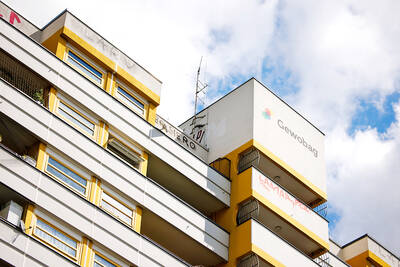Game designer Sam Alfred is keenly aware of the challenge he faces trying to build a video game with climate change at its heart.
Lists of best-selling games are filled with titles pushing destruction and violence rather than constructive engagement with the environment.
Yet Terra Nil, a strategy game designed by Alfred and released in March last year, puts players in charge of rebuilding ecosystems — and has since attracted 300,000 players, publisher Devolver Digital Inc has said.

Photo: EPA-EFE
“I’ve lost count of how many people have dismissed the game or made fun of the game, because of its nature, because it’s a game which is not about shooting people or rampant expansionism,” Alfred said.
“The environment was the focus of the game. The one angle was trying to show players and other game developers and people that it’s possible to build a strategy game without exploitation of the environment,” he said.
True to his word, the 30-year-old South African asks players of Terra Nil to help decontaminate radioactive zones with sunflowers and save the Great Barrier Reef among other climate-related tasks.
He is not the first designer to include an environmental message in their games — nor is he the first to be criticized for it.
In 2017, Cities: Skylines, a city-building game, introduced its Green Cities offshoot, where players could create their ideal metropolis while taking into account pollution and environmental management.
“I remember the Green Cities extension was something that surprisingly polarized the audience,” said Mariina Hallikainen, managing director of Colossal Order, the Finnish studio behind the game.
“There was actually feedback that we are now ruining the game by going political,” she said.
The team behind the game deny there was any overt political message, flagging that players could choose whether to make their city green or not.
Other studios have not been discouraged from putting climate into their games.
The forerunner of all strategy games, Civilization, included climate change in an offshoot of its sixth edition in 2019.
With an estimated 3 billion people playing video games at least once a year, climate campaigners have long targeted them as a potential audience.
Even the UN has tried its hand at creating a climate game — Mission 1.5 — that it said reached more than 6 million people.
Industry figures have joined together in several collectives to see how they can include the climate in their games.
Studios, trade associations and investors formed “Playing for the Planet,” an alliance backed by the UN that has held a “Green Game Jam” each year since 2020.
Other industry figures bandied together to form a climate branch of the International Game Developers Association (IGDA) in 2019.
“You have a superpower: You’re gamemakers,” Arnaud Fayolle, artistic director at Ubisoft Entertainment SA and key mover in the IGDA’s climate branch, told their conference last year.
“You can talk to 3 billion players around the planet who already trust what you have to say, you can teach complex problems in fun and engaging way that schools never can match,” Fayolle said.
The IGDA branch brings together nearly 1,500 industry professionals, professors and ecology and climate specialists, who share their expertise to infuse video games with climate issues and encourage gamers to get involved.
“The idea is to generate a positive cultural impact through aesthetics, storytelling, game mechanics and technology,” Fayolle said.
This is where people like Alfred earn their money.
“A lot of our mechanics in the game are our way of trying to translate either real-life natural processes or real-life ecosystem restoration practices into game form,” he said. “That means oversimplifying them and ... you know, taking some creative liberties.”

When an apartment comes up for rent in Germany’s big cities, hundreds of prospective tenants often queue down the street to view it, but the acute shortage of affordable housing is getting scant attention ahead of today’s snap general election. “Housing is one of the main problems for people, but nobody talks about it, nobody takes it seriously,” said Andreas Ibel, president of Build Europe, an association representing housing developers. Migration and the sluggish economy top the list of voters’ concerns, but analysts say housing policy fails to break through as returns on investment take time to register, making the

‘SILVER LINING’: Although the news caused TSMC to fall on the local market, an analyst said that as tariffs are not set to go into effect until April, there is still time for negotiations US President Donald Trump on Tuesday said that he would likely impose tariffs on semiconductor, automobile and pharmaceutical imports of about 25 percent, with an announcement coming as soon as April 2 in a move that would represent a dramatic widening of the US leader’s trade war. “I probably will tell you that on April 2, but it’ll be in the neighborhood of 25 percent,” Trump told reporters at his Mar-a-Lago club when asked about his plan for auto tariffs. Asked about similar levies on pharmaceutical drugs and semiconductors, the president said that “it’ll be 25 percent and higher, and it’ll

CHIP BOOM: Revenue for the semiconductor industry is set to reach US$1 trillion by 2032, opening up opportunities for the chip pacakging and testing company, it said ASE Technology Holding Co (日月光投控), the world’s largest provider of outsourced semiconductor assembly and test (OSAT) services, yesterday launched a new advanced manufacturing facility in Penang, Malaysia, aiming to meet growing demand for emerging technologies such as generative artificial intelligence (AI) applications. The US$300 million facility is a critical step in expanding ASE’s global footprint, offering an alternative for customers from the US, Europe, Japan, South Korea and China to assemble and test chips outside of Taiwan amid efforts to diversify supply chains. The plant, the company’s fifth in Malaysia, is part of a strategic expansion plan that would more than triple

Taiwanese artificial intelligence (AI) server makers are expected to make major investments in Texas in May after US President Donald Trump’s first 100 days in office and amid his rising tariff threats, Taiwan Electrical and Electronic Manufacturers’ Association (TEEMA, 台灣電子電機公會) chairman Richard Lee (李詩欽) said yesterday. The association led a delegation of seven AI server manufacturers to Washington, as well as the US states of California, Texas and New Mexico, to discuss land and tax issues, as Taiwanese firms speed up their production plans in the US with many of them seeing Texas as their top option for investment, Lee said. The